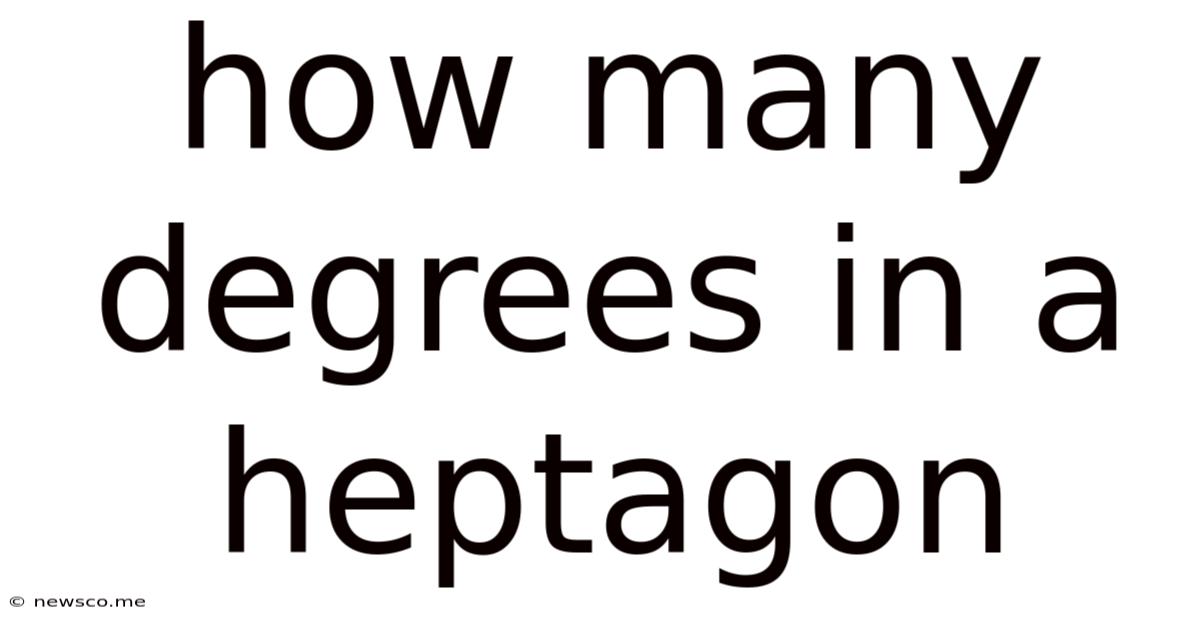How Many Degrees In A Heptagon
News Co
Apr 20, 2025 · 4 min read

Table of Contents
How Many Degrees in a Heptagon? A Comprehensive Guide
The question, "How many degrees in a heptagon?" might seem simple at first glance. However, understanding the answer fully requires delving into the fascinating world of polygons, their interior and exterior angles, and the underlying mathematical principles that govern them. This comprehensive guide will not only answer the question directly but also provide a detailed explanation, exploring related concepts and offering practical applications.
Understanding Polygons: A Foundation
Before we dive into heptagons specifically, let's establish a fundamental understanding of polygons. A polygon is a closed two-dimensional figure with straight sides. Polygons are classified based on the number of sides they have:
- Triangle: 3 sides
- Quadrilateral: 4 sides (squares, rectangles, rhombuses, etc., are all quadrilaterals)
- Pentagon: 5 sides
- Hexagon: 6 sides
- Heptagon (or Septagon): 7 sides
- Octagon: 8 sides
- Nonagon: 9 sides
- Decagon: 10 sides
- And so on…
The number of sides directly influences the polygon's properties, including the sum of its interior angles.
Calculating Interior Angles of a Polygon
The formula for calculating the sum of the interior angles of any polygon is:
(n - 2) * 180°
Where 'n' represents the number of sides of the polygon.
Let's apply this to a few examples:
- Triangle (n=3): (3 - 2) * 180° = 180°
- Quadrilateral (n=4): (4 - 2) * 180° = 360°
- Pentagon (n=5): (5 - 2) * 180° = 540°
- Hexagon (n=6): (6 - 2) * 180° = 720°
This formula works for all polygons, including our heptagon.
How Many Degrees in a Heptagon?
Now, let's answer the central question: How many degrees are there in a heptagon?
Using the formula with n=7 (since a heptagon has 7 sides):
(7 - 2) * 180° = 900°
Therefore, the sum of the interior angles of a heptagon is 900 degrees.
This holds true for any heptagon, regardless of its shape or side lengths. Whether it's a regular heptagon (where all sides and angles are equal) or an irregular heptagon, the total interior angle sum remains 900°.
Understanding Regular vs. Irregular Heptagons
The term "regular" is crucial in geometry. A regular heptagon possesses:
- Equal side lengths: All seven sides are of the same length.
- Equal angles: All seven interior angles are equal.
Since the sum of the interior angles is 900°, each interior angle of a regular heptagon measures:
900° / 7 ≈ 128.57°
An irregular heptagon, on the other hand, has sides and angles of varying lengths and measures. While the sum of its interior angles remains 900°, the individual angles will differ.
Exterior Angles of a Heptagon
Exterior angles are formed by extending one side of a polygon. For any polygon, the sum of its exterior angles (one at each vertex) always equals 360°.
This is true regardless of the number of sides: triangle, quadrilateral, pentagon, heptagon, or any other polygon. The sum of exterior angles remains consistently 360°.
In a regular heptagon, each exterior angle would measure:
360° / 7 ≈ 51.43°
Note that each interior angle and its corresponding exterior angle are supplementary (add up to 180°).
Practical Applications of Heptagon Geometry
While heptagons might not be as commonly encountered as triangles or squares in everyday life, understanding their properties is relevant in various fields:
-
Architecture and Design: Heptagons can be found in some architectural designs, creating unique visual effects. Knowing the angle calculations is crucial for precise construction.
-
Engineering: Certain mechanical parts or designs might incorporate heptagonal shapes, requiring an understanding of their geometric properties for accurate engineering calculations.
-
Computer Graphics and Game Development: Creating realistic 3D models often requires precise geometric calculations. Understanding heptagons and their properties is essential for accurate rendering and animation.
-
Tessellations and Patterns: Heptagons can be used in creating various tessellations (tilings) and patterns, particularly in artistic and design contexts. The understanding of angles is important for the seamless continuation of patterns.
Advanced Concepts and Further Exploration
For those interested in delving deeper, here are some advanced concepts related to heptagons:
-
Construction of a Regular Heptagon: Constructing a regular heptagon using only a compass and straightedge is not possible. This is because 7 is not a Fermat prime. Approximation methods are required.
-
Heptagonal Numbers: These are figurate numbers that can be represented visually as heptagons. They form a sequence related to the number of dots required to form larger heptagons.
-
Symmetry Groups: Heptagons possess certain symmetry properties that can be explored using group theory.
-
Relationship to Other Polygons: Exploring the relationship between heptagons and other polygons (especially those related through geometric transformations) offers further insights into geometry.
Conclusion: Mastering Heptagon Geometry
Understanding the properties of a heptagon, particularly the sum of its interior angles (900°), is fundamental to various applications across different fields. This guide has provided a comprehensive overview, exploring the core principles, practical implications, and advanced concepts. Remember, the foundation of geometry lies in understanding the relationships between shapes and their properties. Whether you're a student, an architect, an engineer, or simply someone curious about mathematics, grasping the concepts discussed here will enhance your understanding of geometry and its real-world applications. By understanding the fundamental principles and formulas, you can confidently approach any problem involving heptagons and other polygons.
Latest Posts
Related Post
Thank you for visiting our website which covers about How Many Degrees In A Heptagon . We hope the information provided has been useful to you. Feel free to contact us if you have any questions or need further assistance. See you next time and don't miss to bookmark.